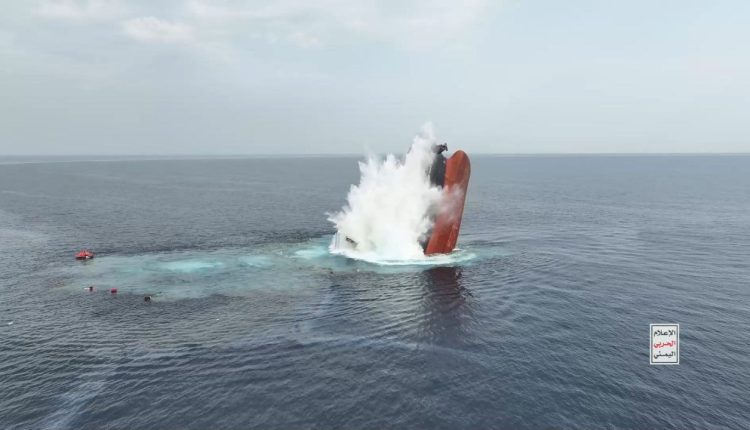SANAA, July 19 (YPA) – While all eyes were on southern Lebanon, anticipating a full-scale confrontation with Hezbollah and an open conflict between Iran and the Israeli occupation, at a time when the Israeli occupation believed it had settled the issue of the major regional fronts—from southern Lebanon to Syria and even the Iranian hinterland—the Yemeni front emerged as an unexpected strategic shift, upsetting the balance of power in the calculations of the occupation government and the US administration.
In an analysis by Yemen Pres Agency, it imposed a new regional deterrence equation, redrawing the map of confrontation in the ongoing aggression against the Gaza Strip.
In the midst of the raging war of aggression against Gaza, the Sanaa forces not only declared a support stance, but also opened an effective operational front, tipping the scales of the conflict and expanding the arenas of attrition against the Israeli occupation and its allies in the Red Sea.
Suddenly, Yemen forcefully has entered the deterrence equation, drawing new red lines and forcing Washington and Tel Aviv to deal with a front that had not been on their radar screens. Thus, Yemen emerged not only as an ally in the axis of resistance, but also as a regional power that asserted its effective presence at the heart of the battle and redefined who the true partner was in confronting the Zionist project.
Yemen: An Active Front
Since the beginning of 2024, it has become clear that Sanaa forces have shifted from a position of symbolic support to direct action, opening a new front from the Red Sea coast, targeting the heart of Israeli and Western interests and striking the strategic depth of the occupation, not only militarily, but also economically and politically.
This prompted the spokesman for the Qassam Brigades, Abu Obeida, to pay exceptional tribute to Yemen, praising the great stance and positive role by the Yemeni people ad its armed forces in supporting the Palestinian people and imposed an active front on the Israeli enemy.
Since the outbreak of the aggression on Gaza in October 2023, the occupation’s attention has been focused on three main fronts: Hezbollah in Lebanon, the Assad regime in Syria, and Iran as a major player in the axis of resistance. Sanaa—despite its explicit membership in this axis—was not included in the “bank of urgent threats” in Israeli assessments.
According to Israeli estimates, this was a grave miscalculation for the occupation, and the United States and the West. While the Israeli occupation was preparing to launch a northern war against Lebanon, destroy the capabilities of the Syrian army, and launch a preemptive strike on Iranian nuclear facilities, Yemeni missiles and drones were targeting logistical support ships for the Israeli occupation’s allies, striking its ports and maritime trade routes, paralyzing shipping in the Red Sea, the Arabian Sea, and the Bab al-Mandab Strait.
This year, they have imposed an air blockade after threatening navigation at Ben Gurion Airport in the Lod area.
In fact, according to statements by Yemeni diplomatic and military leaders, Sanaa received tempting American offers, including lifting the blockade on Yemen and halting the war in exchange for halting its support for Gaza and not opening a Red Sea front.
But Sanaa, according to statements by leaders of Palestinian resistance factions, rejected these bargains at the expense of the blood of the Palestinian people, preferring to fight the battle of dignity alongside the Palestinian people, despite the security, political, and economic repercussions.
The Battle to Impose Will
In an unprecedented move since World War II, Sanaa succeeded in becoming the first regional power to force Washington into direct truce negotiations, after all attempts to break its air and naval defenses had failed.
This was not a symbolic battle or mere fiery messages; it was a strategic war of attrition by all standards, which forced US forces to withdraw aircraft carriers from the Red Sea, the Gulf of Aden, and some of its bases in the Gulf states.
These strikes halted most shipping routes linked to the Israeli occupation across the Red Sea, leading to the collapse of tourism in Eilat port and the damage to the Israeli economy of more than $15 billion by last May, according to Israeli estimates. Washington was forced to sign a partial truce agreement with Sanaa last June after its coalition had failed to achieve any significant progress on the ground.
These qualitative and unprecedented results prompted the resistance factions, led by al-Qassam Brigades, to assert that the Yemeni front was not only supportive, but also effective and influential, and had forced the occupation to undertake a comprehensive strategic reassessment.
A Moral Scandal for the Normalization Regimes
What is striking about the Yemeni position—as Abu Obeida pointed out—is that it “established an argument against those who sit back and are submissive,” referring to the Arab regimes that have chosen to remain silent or complicit in the daily scenes of Israeli massacres and starvation in the Gaza Strip.
While most Arab capitals were content with formal statements of condemnation or statements of humanitarian support, Yemen’s Sanaa opened a real battlefront, engaging in direct combat with American and Israeli forces and paying a heavy military and political price. This represented a grave embarrassment to the normalization system and exposed the falsity of slogans calling for “regional peace.”
This explains the American and Israeli anger at the Yemeni actions and the escalation in the frequency of raids and threats over the past months, which had failed to break Sanaa’s will or neutralize it from the battle.
Despite the intensity of American and Israeli airstrikes and repeated threats, Sanaa has remained steadfast in its position, affirming in every official speech that it would not compromise on the blood of Gaza’s children and would not back down from its support for the resistance, even if the entire Red Sea is on fire.
A Multi-Front Deterrence Equation
Military analysts and strategic experts, in statements to regional and international news channels, confirm that Yemen’s involvement in the regional war represents a shift in the nature of the conflict, redefining the concepts of deterrence and strategic parity. It is no longer the “conventional power centers” alone that are shaping the battle, but rather the will and ability to direct strategic damage to enemy interests.
The new deterrence equation now relies on the ability to threaten the enemy’s vital interests beyond geography.
In this context, it became clear that Sana’a’s forces had transcended the logic of a “symbolic response” to real action that impacted the course of the war, the enemy’s morale, and even the American and Israeli supply and support lines. This action disrupted the enemy’s logistical and diplomatic calculations, placing the occupation in a state of exhaustion not seen since the October 6, 1973 war.
Prospects for the Next Phase
While the Palestinians have been waging their legendary battle in Gaza against the genocidal machine, Sanaa formed a pressure front that disrupted the calculations of the Western allies of the Israeli occupation, redefined the concept of “partnership in resistance,” and embarrassed all onlookers on the sidelines.
Indeed, it can say that Yemen was not merely a supporter, but a regional player reengineering the region’s balances with independent decision-making and a firm will.
The Red Sea may be witnessed new transformations in the coming period, and the United States may find itself facing a long-term equation of attrition, led by unconventional parties that cannot be blackmailed or contained. Ultimately, Sanaa has proven that it was not just a supportive state, but rather a strategic partner that imposed a different kind of battle on the enemy, making the Red Sea a new red line in the regional equation.
AA


